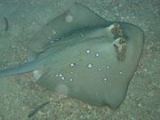
Neotrygon
Encyclopedia
The maskrays are a genus
, Neotrygon, of stingray
s, family Dasyatidae, native to the Indo-West Pacific
. They are so named because of a distinctive color pattern around their eye
s, resembling a mask
. The species in this genus were originally placed in the genus Dasyatis
by most authors. However, recent morphological and molecular analyses have conclusively showed that they represent a distinct group, and so the genus Neotrygon was resurrected for them.
Aside from their mask-like color pattern, the maskrays are variable in coloration and can be plain or ornate. Their pectoral fin discs are largely smooth, with a single row of thorns along the dorsal midline. The mouth
is small with two central papilla
e and a row of enlarged, long-cusp
ed teeth halfway along the upper jaw on both sides. The nasal curtain, formed by the merging of the nasal flaps, is long and narrow. The tail
is very short with well-developed dorsal and ventral fin folds and a filamentous tip, and is banded black and white past the stinging spine. In addition, Neotrygon species also differ from other stingrays in their buccal
and skeletal morphology, as well as in the CO1 gene
.
Genus
In biology, a genus is a low-level taxonomic rank used in the biological classification of living and fossil organisms, which is an example of definition by genus and differentia...
, Neotrygon, of stingray
Stingray
The stingrays are a group of rays, which are cartilaginous fishes related to sharks. They are classified in the suborder Myliobatoidei of the order Myliobatiformes, and consist of eight families: Hexatrygonidae , Plesiobatidae , Urolophidae , Urotrygonidae , Dasyatidae , Potamotrygonidae The...
s, family Dasyatidae, native to the Indo-West Pacific
Indo-West Pacific
The Indo-West Pacific, or IWP, is a zoogeographical region spanning the entire Indian Ocean including the Red Sea and the Pacific Ocean as far as the Caroline Islands but short of the Marshall Islands...
. They are so named because of a distinctive color pattern around their eye
Eye
Eyes are organs that detect light and convert it into electro-chemical impulses in neurons. The simplest photoreceptors in conscious vision connect light to movement...
s, resembling a mask
Mask
A mask is an article normally worn on the face, typically for protection, disguise, performance or entertainment. Masks have been used since antiquity for both ceremonial and practical purposes...
. The species in this genus were originally placed in the genus Dasyatis
Dasyatis
Dasyatis is a genus of stingray. The members of the genus Neotrygon were formerly included in Dasyatis.-Species:...
by most authors. However, recent morphological and molecular analyses have conclusively showed that they represent a distinct group, and so the genus Neotrygon was resurrected for them.
Aside from their mask-like color pattern, the maskrays are variable in coloration and can be plain or ornate. Their pectoral fin discs are largely smooth, with a single row of thorns along the dorsal midline. The mouth
Mouth
The mouth is the first portion of the alimentary canal that receives food andsaliva. The oral mucosa is the mucous membrane epithelium lining the inside of the mouth....
is small with two central papilla
Papilla (fish mouth structure)
The papilla, in certain kinds of fish, particularly rays, sharks, and catfish, are small lumps of dermal tissue found in the mouth, where they are "distributed uniformly on the tongue, palate, and pharynx"...
e and a row of enlarged, long-cusp
Cusp (dentistry)
A cusp is an occlusal or incisal eminence on a tooth.Canine teeth, otherwise known as cuspids, each possess a single cusp, while premolars, otherwise known as bicuspids, possess two each. Molars normally possess either four or five cusps...
ed teeth halfway along the upper jaw on both sides. The nasal curtain, formed by the merging of the nasal flaps, is long and narrow. The tail
Tail
The tail is the section at the rear end of an animal's body; in general, the term refers to a distinct, flexible appendage to the torso. It is the part of the body that corresponds roughly to the sacrum and coccyx in mammals, reptiles, and birds...
is very short with well-developed dorsal and ventral fin folds and a filamentous tip, and is banded black and white past the stinging spine. In addition, Neotrygon species also differ from other stingrays in their buccal
Buccal
Buccal may refer to:* Mouth, a body cavity** Specifically the cheek* Buccal artery...
and skeletal morphology, as well as in the CO1 gene
Gene
A gene is a molecular unit of heredity of a living organism. It is a name given to some stretches of DNA and RNA that code for a type of protein or for an RNA chain that has a function in the organism. Living beings depend on genes, as they specify all proteins and functional RNA chains...
.
Species
- Neotrygon annotata (Last, 1987) (Plain maskray)
- Neotrygon kuhlii (J. P. MüllerJohannes Peter MüllerJohannes Peter Müller , was a German physiologist, comparative anatomist, and ichthyologist not only known for his discoveries but also for his ability to synthesize knowledge.-Early years and education:...
& HenleFriedrich Gustav Jakob HenleFriedrich Gustav Jakob Henle was a German physician, pathologist and anatomist. He is credited with the discovery of the loop of Henle in the kidney. His essay "On Miasma and Contagia" was an early argument for the germ theory of disease...
, 1841) (Blue-spotted stingray) - Neotrygon leylandi (Last, 1987) (Painted maskray)
- Neotrygon ningalooensis Last, W. T. White & Puckridge, 2010
- Neotrygon picta Last & W. T. White, 2008 (Peppered maskray)

